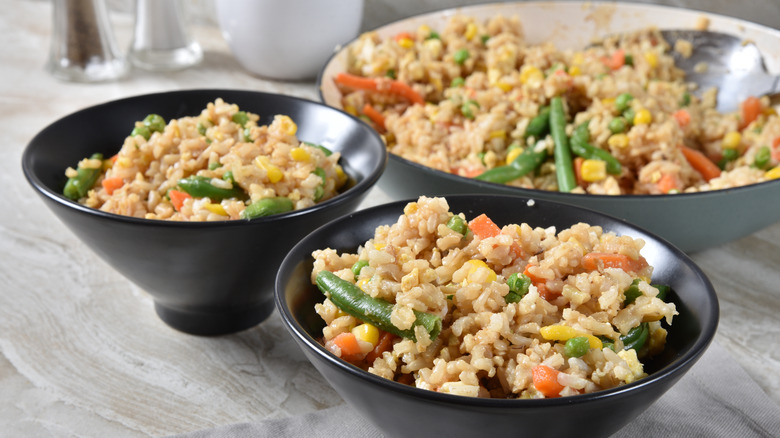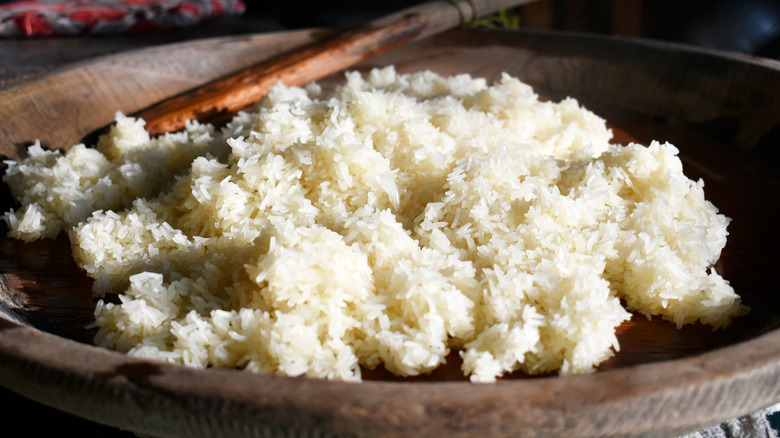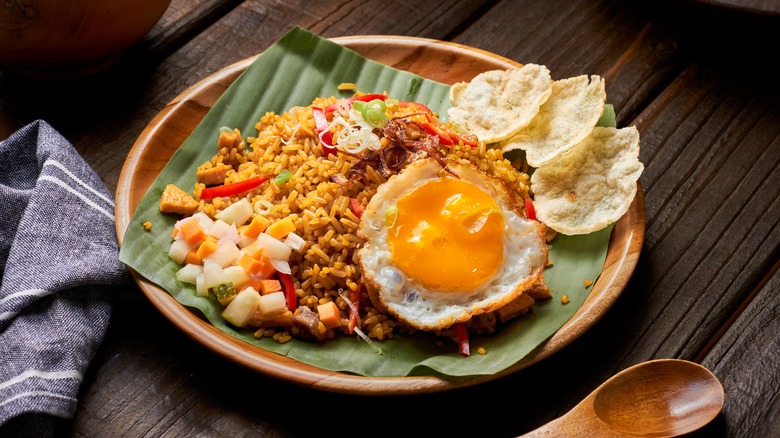The Hassle-Free Hack For Bragworthy Fried Rice
There's nothing quite like fried rice from your favorite takeout restaurant: warm, fluffy, perfectly-separated grains of rice studded with morsels of vegetables and meat. For folks who want to learn to replicate this meal at home, there are many mistakes that can be avoided when cooking fried rice. A common complaint is that homemade fried rice is clumpy, which results in an unevenly-seasoned plate of food. Fortunately, there's an easy, hassle-free hack to avoid this problem: Use cooked rice that has been sitting in the fridge overnight. In other words, use leftover rice.
What makes using leftover cooked rice key? The surface of freshly-cooked rice is quite moist, thanks to its steamy cooking environment. The longer rice sits out, uncovered, the more it dries out from the surface inward. Leaving rice uncovered on the counter can be much too risky, inviting bacteria spores to proliferate (according to the NHS), but storing it in the fridge lets it dry out more safely, resulting in separated grains and a pleasant chew.
Incidentally, leftover rice has been found to be better for diabetics. Research in the journal Foods has shown that when rice is stored in colder temperatures, its glycemic index is altered, making the starches contained within less accessible for the body to digest and absorb.
No leftover rice? Great fried rice is still possible
Why does drier rice work better for fried rice? It is all about even distribution: Separate grains allow for both even seasoning and for the add-ins to be mixed much more evenly with the rice. Drier rice also absorbs flavors better, as any liquid seasonings added to the pan while frying will essentially slightly re-steam the rice, incorporating flavors directly into the grains. You can even use leftover rice that has been frozen instead of refrigerated, and it will cook up in similar ways.
But what if you do not have leftover rice? What if you did not plan ahead and all you have to work with is freshly-cooked rice? The easiest way is to spread freshly-cooked rice on a plate or baking sheet to quickly cool it down. Bonus points if you can direct an electric fan toward the rice to rapidly drive off surface moisture. You can also manually break up the clumps of rice with a lightly-oiled hand. This will both give a thin barrier of oil to the individual grains of rice, and also prevent rice from sticking to your hand.
Cooking the perfect rice for frying
There are a couple more methods you can follow when cooking up the initial batch of rice to ensure the grains will be ideal for frying. The first is to remove as much excess starch as possible before cooking. This can be achieved by placing uncooked rice in a sieve and running the grains under while agitating them with your fingers for a few seconds. This step alone will almost guarantee rice that is less starchy, which will result in less clumping during the frying process.
Another method that can help is to alter the ratio of liquids to raw rice when setting the rice to cook. Whether in a dedicated rice cooker or in a pot over a burner, use 1-2 ounces less liquid than you usually would. This will result in cooked rice that is drier to begin with, perfect for soaking up just the right amount of flavors during frying.


